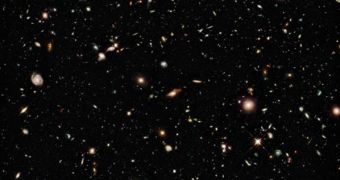Benefiting from its newly revamped scientific instruments, the Hubble Space Telescope has recently taken one of the most amazing pictures ever. Using infrared wavelengths, the observatory was able to imagine galaxies so far away from the Earth, that they must have formed just 600 million years after the Big Bang exploded the Universe into being, more than 13.7 billion years ago. Researchers are ecstatic at the new deep-field view that could give them clues on how galaxies first appeared and evolved.
According to the team that operated Hubble for the new investigation, the image shows galaxies that existed as far as 13.1 billion light-years from the Earth, which is the farthest such distance ever imaged. The red and faint objects could only be resolved thanks to the Wide Field Camera 3 (WFC3), the new set of eyes that was added to the instrument earlier this year, during a shuttle Atlantis mission. The WFC3 proved in earlier testing stages of the mission to be extremely apt at catching this type of photos.
“The expansion of the universe causes the light from very distant galaxies to appear redder, so having a new camera on Hubble which is very sensitive in the infrared means we can identify galaxies at much greater distances than was previously possible,” Oxford University postdoctoral researcher in astrophysics Stephen Wilkins explains. He has also been a member of the team that conducted the new research. The image is contained within the Hubble Ultra Deep Field, and was collected during sessions carried out this August, Space reports.
“Hubble has now revisited the Ultra Deep Field, which we first studied five years ago, taking infrared images which are more sensitive than anything obtained before. We can now look even further back in time, identifying galaxies when the Universe was only 5 percent of its current age – within 1 billion years of the Big Bang,” Cambridge Institute of Astronomy postdoctoral researcher and team member Daniel Stark adds. Experts admit that, at this point, the farthest known object is a GRB (gamma-ray burst), which was definitely generated before the Universe turned 1 billion years.
“These new observations from HST are likely to be the most sensitive images Hubble will ever take, but the very distant galaxies we have now discovered will be studied in detail by Hubble's successor, the James Webb Space Telescope, which will be launched in 2014,” University of Edinburgh expert Jim Dunlop, who has also been involved in the new research, says. Details appear in the latest issue of the scientific journal Monthly Notices of the Royal Astronomical Society.

 14 DAY TRIAL //
14 DAY TRIAL //